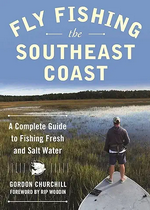Don’t you just love the wind! The wind is every fly caster’s worst nightmare. It means our accuracy goes kaput and we run the risk of catching ourselves with our own fly.
But we live near the ocean and the wind is with us, like it or not. It does keep the bugs away, after all. So, we might as well embrace the wind and figure out how to deal with it. Remember what Lefty said: if you can cast 100’ you have good enough technique to be able to cast 30’ into the wind.
Ideally, we want whatever wind there is to be coming over our off-hand shoulder. This way, the wind is moving the line (and fly with its sharp hook) away from us. Also, if you are in a situation where a guide or generous owner is in charge of the boat, know that they will do everything they can to move the boat around so it is blowing over our off-shoulder. But that is not always possible. If there are two anglers in the boat, the guide will have to figure out which angler he wants to hit him in the head with his fly. Not good. But don’t give up yet.
1. Try casting side-arm since the wind is usually lower the closer you get to the ground. This is hard to do this if there are obstructions behind you. The main challenge is convincing yourself that your back cast will not fall to the ground if you cast with a certain authority and don’t wait too long to make the forward cast. Even if the fly does fall to the water, the angler can do what is called a “water haul” in which the surface tension of the fly line coming off the water deepens the bend of the rod for the forward cast.
2. Turn around and make a backward cast, beginning with a forward cast as your back cast and a subsequent back cast as your forward cast. Release the line to shoot it while making the back cast that is really your forward cast toward your target. The biggest challenge is aiming your cast correctly since the target is behind you.
3. When facing into the wind, you can make a high back cast (with the wind) and then a low forward cast into the wind. A tight loop really helps. Be careful not to try too hard because too much extra power will cause your cast to break down into a pile. Instead of a lot more power in your rod hand, be energetic with your line hand on the double haul.
4. If you are casting with the wind, make a low back cast and a higher forward cast. This allows the back cast to stay low where the winds are not quite as strong and the forward cast gets to be “carried” by the wind.
5. You can learn to cast with either hand so you can switch to the hand that gives you the most advantage. It will take a lot of practice but you will never regret having this ability. Boat owners and guides will love you for this skill.
Don’t forget to check out the resources of Fly Fishers International at www.flyfishersinternational.org.
Also, Google this and other topics of interest and go to YouTube for seemingly endless videos.



